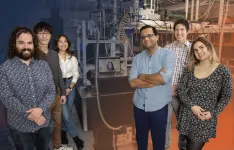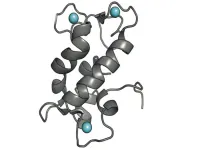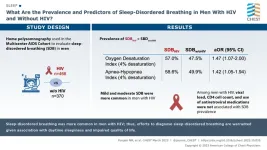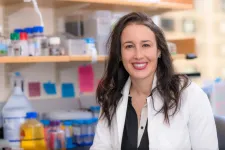Researchers at the University of Illinois Urbana-Champaign have detected the existence of a charge density wave of electrons that acquires mass as it interacts with the background lattice ions of the material over long distances.
This new research, led by assistant professor Fahad Mahmood (Physics, Materials Research Laboratory) and postdoc Soyeun Kim (current postdoc at Stanford Institute for Materials and Energy Sciences, SLAC National Accelerator Laboratory), is a direct measurement of the Anderson-Higgs mechanism (of mass acquisition) and the first known demonstration of a massive phason in a charge density wave material, a prediction made more than 40 years ago.
Their paper, “Observation of a massive phason in a charge density wave insulator,” with these results, was recently published in Nature Materials.
The collective excitations of condensed phases of matter often play a foundational role in developing fundamental theories for a variety of materials, including superconductors, quantum magnets, and charge density waves. In a simple metal, electrons are distributed uniformly across space; electron density at one point in space is equal to that of another point in space. In certain metals, however, the electron density develops a sinusoidal (wave) pattern (a charge density wave). Mahmood explains that, considering the charge density wave as frozen in space, if the wave is disturbed, it is going to “ring” (that is, its collective excitations are generated). It can ring by a change in the amplitude of the wave pattern, or the charge density wave can slide back and forth (phase shifting). The later collective excitation is dubbed the phason and is similar to sound waves in a material – it has negligible mass.
More than 40 years ago, researchers predicted that if the phason interacts strongly with the background lattice of ions over long-distances (long-range Coulomb interactions), then it will try to drag the heavy ions as it moves. As a result, the phason will require a lot more energy to get it to move – the phason is said to “acquire mass”. This mass acquisition of a phason is believed to occur due to the same mechanism by which all fundamental massive particles in the universe acquire mass (a phenomena known as the Anderson-Higgs mechanism). Direct observation of this mass acquisition has remained elusive, primarily because long-range Coulomb interactions do not exist in most charge density wave materials.
The material used in this research, tantalum selenium iodide ((TaSe4)2I), is a very good insulator at low temperatures and is one of the best-known insulators for charge density waves. Because of that, long-range Coulomb interactions are likely to be present in the system and those interactions can give mass to the otherwise massless excitation. In theory, if the material is heated, it would become less insulating, the Coulomb interactions would weaken, and the massive phason should become massless.
Mahmood, Kim, and their collaborators were able to investigate the charge density wave phason in (TaSe4)2I by developing a nonlinear optical technique known as time-domain terahertz (THz) emission spectroscopy at low temperatures (less than 10 K, -442° F). Using this technique, an ultrafast infrared laser pulse, lasting less than 150 fs (1 fs is a millionth of a billionth of second), was shined on the (TaSe4)2I sample, generating the collective excitations of the system. What they detected was the massive phason radiating in the THz region of frequencies, with a very narrow bandwidth. When they heated the material, the massive phason became massless (stopped radiating), matching up with long-standing theoretical predictions.
While (TaSe4)2I is conducive to hosting a massive phason, it can be a very challenging material to work with because it grows as very thin needles making sample alignment very difficult. Kim described the process “like trying to shine a light on the side of a chopstick”. A collaborator on this research, Daniel Shoemaker (associate professor, MatSE, UIUC), was able to grow (TaSe4)2I crystals with substantially large width, which enabled the application of THz emission spectroscopy on this material.
“It is gratifying to see that a collective mode predicted many years ago is finally seen experimentally,” commented Patrick Lee, the William & Emma Rogers Professor of Physics at MIT, and one of the pioneers of the theoretical works predicting the massive phason in charge density waves. “It speaks to the power of modern nonlinear optical techniques and the ingenuity of the experimentalists. The method is general, and we may see applications to other collective modes as well.”
At an applied level, generating narrowband radiation in the THz region of frequencies can be very difficult. However, due to the strikingly narrow bandwidth THz radiation resulting from the massive phason in (TaSe4)2I, the possibility of developing it (and other such materials) as a THz emitter is quite promising. The frequency and intensity of this THz emission can potentially be controlled by varying sample properties, applying external magnetic fields or strain.
Mahmood summarizes, “This is the first known demonstration of a massive phason in a charge density wave material and settles the long-standing question of whether a charge density wave phason acquires mass by coupling to long-range Coulomb interactions. This is a major result that will have a profound impact on the field of strongly correlated materials, and in the understanding of the interplay between interactions, density-wave ordering and superconductivity in materials.”
Other contributors to this work include Yinchuan Lv (grad student, Physics, UIUC), Xiao-Qi Sun (postdoc, Physics, UIUC), Chengxi Zhao (grad student, MatSE/MRL, UIUC), Nina Bielinski (grad student, Physics/MRL, UIUC), Azel Murzabekova (grad student, Physics/MRL, UIUC), Kejian Qu (grad student, Physics/MRL, UIUC), Ryan A. Duncan (postdoc, Stanford PULSE Institute/Stanford Institute for Materials and Energy Sciences, SLAC National Accelerator Laboratory), Quynh L. D. Nguyen (project scientist, Stanford PULSE Institute/Stanford Institute for Materials and Energy Sciences, SLAC National Accelerator Laboratory), Mariano Trigo (lead scientist, Stanford PULSE Institute/Stanford Institute for Materials and Energy Sciences, SLAC National Accelerator Laboratory), and Barry Bradlyn (assistant professor, Physics, UIUC).
END







